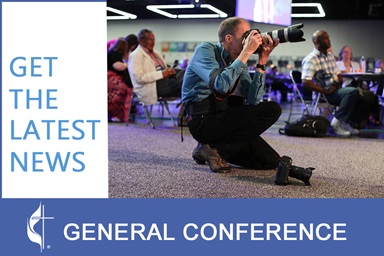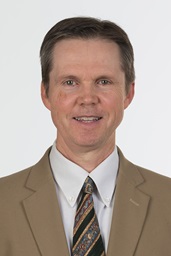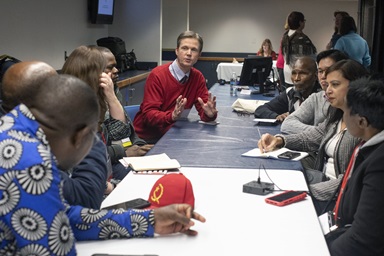When Joseph Briddock’s family found a handmade quilt among the tins of food in a CARE package delivered to their South London home, the only clue to its origin was a notation on the back: a gift from “the Methodist Ladies of New York.”
Seventy years later, those words have faded with time, but Briddock’s curiosity remains intact. He would love to tell those women, or their families, what the gift meant at the end of World War II.
“During the war my mother ‘traded’ ration coupons with other women, (such as) clothing coupons for food, so when she got the quilt, she was really happy to have something of real use,” Briddock explained in an email to United Methodist News Service. “We took the quilt with us into the air-raid shelters to keep warm, so it was of real value.”
As Camila Ruz reported in an Oct. 17 story for BBC News Magazine, Briddock was 9 years old when the box arrived. While his father was fighting in North Africa, his mother, Annie, kept the family — including his brother and two sisters — together through food rationing and bombings.
His father returned safely from the war, and his mother carefully looked after the quilt, which Briddock said “served many years of domestic duty” until her death in 1978.
Lingering effects of World War II
Ruz contacted Briddock after learning about his story through CARE’s press team. “It really brought home how recent the war had been and its lingering effects,” she said. “It’s one thing to read about it in the history books and quite another to hear directly from someone who saw it all. The more we spoke, the more obvious it became that we should tell his story.”
Sending a CARE Package
The first CARE packages utilized stocks of unused army rations. Later, the relief agency began assembling its own food packages with flour, butter and other staples, along with brand names still familiar today, such as Hunts tomatoes, Uncle Ben’s rice.
Corporations began supporting CARE by sending packages to employees in their European offices. Many other groups — church groups, Boy Scouts, celebrities, even former U.S. presidents — purchased CARE packages and sent them to Europe.
It’s likely the “Methodist Ladies of New York” or their congregation purchased the package of food that included the quilt the Briddock family received.
The story of who put the quilt into the CARE package is still unknown.
Mark Shenise, a staff member of the United Methodist Commission on Archives and History, said the phrase "Methodist Ladies of New York" implied the quilt was either a project by the New York Annual Conference Women’s Society of Christian Service (WSCS) or a mission project by a group of women in one or more local congregations.
Beth Patkus, archivist for the New York Conference, told UMNS she had seen references to quilting in old records. “I think it is most likely something that was done on the local church level,” she added.
While Patkus could not find a specific reference to the Briddock quilt, she did find mention of the exhibition of “a box of partly finished garments prepared to be sent to relief in Europe” in the June 18, 1947, minutes of the regular quarterly meeting for the executive board, WSCS, New York East Conference.
“It does certainly indicate they were doing something to contribute,” she noted.
Interest, but no luck on Facebook
When the BBC contacted United Methodist Women about the quilt, the organization did some checking in the New York and Upper New York conferences and shared a photo of Briddock with the quilt on its Facebook page.
“We received a lot of support and shares, but no clear leads that I know of on the members or family members of the ‘Methodist Ladies of New York,’" said Tara Barnes, interim editor of UMW’s Response Magazine.
UMW members still use quilting, knitting and sewing as a means of ministry, said Sally Vonner, the staff executive for membership and leadership development.
Some women have relationships with United Methodist-related hospitals or their auxiliaries, for example, and create caps, booties, knitted outfits and blankets for families to take home with their newborn babies. “It’s a way that many of our members have been in mission in their local communities,” she noted.
Other UMW groups have prayer quilt ministries. During the 2012 United Methodist General Conference in Tampa, Florida, UMW organized a prayer ministry space where attendees could create a fabric prayer square as a quilt representing the prayers and emotions of the denomination’s top legislative gathering was stitched together.
For the upcoming 2016 General Conference next spring in Portland, Oregon, UMW is asking its members to make quilt squares featuring a labyrinth that can be traced with a finger. The squares will be distributed to every General Conference delegate, Vonner said.
Still looking for clues
For Briddock’s family, the quilt from the anonymous “Methodist ladies” provided comfort during a difficult time and created a lasting emotional connection that prompted him to take the quilt to his home after his mother’s death.
Briddock and his wife, Muriel, still have the quilt at their home in Dublin, where they moved 51 years ago from London. “We have four wonderful children and enjoy life,” said Briddock, who worked as a structural design engineer.
Despite the lack of clues, he still hopes to be able to express his gratitude to the quilt’s creators.
Bloom is a United Methodist News Service multimedia reporter based in New York. Follow her at https://twitter.com/umcscribe or contact her at (646) 369-3759 or [email protected]
Like what you're reading? Support the ministry of UM News! Your support ensures the latest denominational news, dynamic stories and informative articles will continue to connect our global community. Make a tax-deductible donation at ResourceUMC.org/GiveUMCom.






